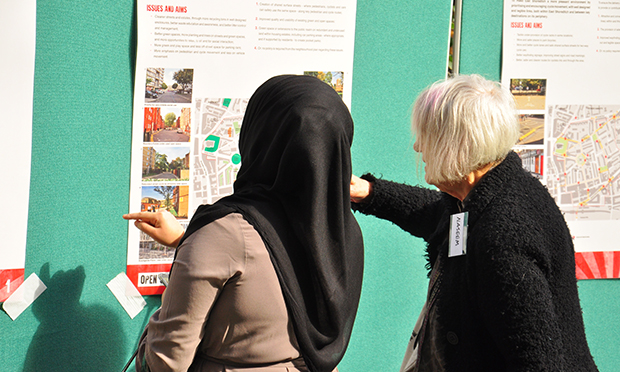How citizens are seeking to solve the housing crisis from the bottom up

Having a say: Residents at the forum’s community outreach day in Autumn 2015
Is there space in Hackney for everybody? Will my children be able to afford to stay in the borough? And why do developers seem to get away with offering so little affordable housing?
Such questions are all too familiar in an inner London borough, not least in Hackney, the local authority revealed last month to have the eighth fastest growing population in England.
By 2024, the number of people living in the borough is set to increase by 43,100 (16.4 per cent).
London is being squeezed, and Hackney is at the sharp end. No wonder grassroots projects to tackle the growing number of heads are sprouting up in East London.
Now residents in Shoreditch have hatched a plan to shape how their neighbourhood develops.
Rebecca Collings set up the East Shoreditch Forum (ESF) in response to the “intense development pressure” on the area.
“The minute there’s a spare square of land round here someone wants to put 25 storeys on it or luxury flats,” says Collings, who lives on Chance Street.
“It’s all at the expense of the local community. People get priced out of the neighbourhood.
“If you can afford a croissant at £2.50 then good for you. If not, you are excluded, which enhances the problem of cultural separation.
“The gentrification process is inevitable but you must take community with you. Otherwise it’s a recipe for social unrest.”
Collings decided that the only way for the community to have more control over what was going on around them would be to launch a Neighbourhood Plan.
In 2011, the Localism Act introduced the right for residents and businesses to help shape development through the production of Neighbourhood Development Plans and other Orders.
The policies put forward can eventually form part of the Local Plan, helping to determine planning applications and shape where developments will go and how they will look.
After an arduous process of agreeing the neighbourhood boundary with Hackney and Tower Hamlets councils, Collings rallied neighbours for ideas.
“Residents of a neighbourhood know more about it than any professional,” says Collings.
“They’re dealing with dog fouling, anti-social behaviour – all the things that make a neighbourhood good or bad to live in – every day.”

Cllr Rachel Blake, Tower Hamlets’ cabinet member for strategic development. Photograph: Tower Hamlets Council
Cllr Rachel Blake, Cabinet Member for Strategic Development at Tower Hamlets Council, has helped support the ESF through the process.
Judging by her experience in Hackney’s neighbouring borough, Cllr Blake says asking residents where to build houses is a good example of how a neighbourhood plan can work.
“Our council has housing targets to meet. We are at the forefront of the addressing housing crisis and need residents. We have 20,000 households on the waiting list who are in desperate need of new affordable homes.”
Members of the East Shoreditch Forum have suggested bollards be removed from certain streets to make it easier for cyclists. “Only residents would have been able to come up with that,” Blake points out.
“So it’s important we make the most of their knowledge and understanding of area, rather than just imposing ideas on them, as some developers or housing associations can do.
“We need to ensure that residents feel a part of that decision making.”
The role of councils in the process is to support the Neighbourhood Forum. The council approves the forum and its boundaries, then supports the forum through the process – for example by advising on planning legislation.
Cllr Blake hopes the community-led planning will set a “positive example” to Housing Associations that are seeking to build new homes.
“By working from the ‘bottom up’ – encouraging meaningful and significant engagement from the very start of the process – proposals from Housing Associations are more likely to go down well with residents.”
“And it means developers are less likely to face opposition to their plans and residents feel they have some agency in shaping their area.”
